Multi-Source Remote Sensing Data Product Analysis: Investigating Anthropogenic and Naturogenic Impacts on Mangroves in Southeast Asia
Abstract
:1. Introduction
2. Materials and Methods
2.1. Data Used in This Study
2.1.1. Mangrove Data Product and Change
2.1.2. Land Use Land Cover Data Products
2.1.3. Geophysical and Vegetation Parameter Products from Remotely Sensed Data
2.2. Methodology
2.2.1. Harmonization of Land Cover Data Product
2.2.2. MODIS Vegetation Indices
2.2.3. Mangrove’ Coefficient Growth
2.2.4. Mangrove Forests’ Water Balance
Peff(Green Water) = 1253 + 0.1P if P > 250/3 mm
3. Results
3.1. Spatiotemporal of MODIS Vegetation Indices in Mangrove Area
3.2. Results of Land Cover Conversion from Deforested Mangroves in Southeast Asia
3.3. Mangrove Coefficient Growth
3.4. Mangrove Forests’ Water Balance for Degradation and Depletion Identification
4. Discussion
4.1. Mangrove Agreement Level
4.2. Conformity of Data Products with DLUDMP and SEAMCT
4.3. Uncertainties in Mangrove Change Data
4.4. Trend Analysis and Breakpoint Detection on Deforested and Degraded Mangrove Area
4.5. Future Possible Directions
5. Conclusions
Author Contributions
Funding
Acknowledgments
Conflicts of Interest
References
- Tomlinson, P.B. The Botany of Mangroves; Cambridge University Press: New York, NY, USA, 1986; ISBN 0-521-25567-8. [Google Scholar]
- Alongi, D.M. Introduction in the Energetics of Mangrove Forests; Springer Science and Business Media BV: New York, NY, USA, 2009; pp. 47–64. [Google Scholar]
- Kathiresan, K.; Bingham, B.L. Biology of mangroves and mangrove ecosystems. Adv. Mar. Biol. 2001, 40, 81–251. [Google Scholar] [CrossRef]
- Brown, D. Mangrove: Nature’s Defences against Tsunamis; Environmental Justice Foundation: London, UK, 2004; ISBN 1-904523-05-7. [Google Scholar]
- Feller, I.C.; Sitnik, M. Mangrove Ecology Workshop Manual; Smithsonian Institution: Washington, DC, USA, 1996. [Google Scholar]
- Kirui, B.; Kairo, J.G.; Karachi, M. Allometric Equations for Estimating Above Ground Biomass of Rhizophora Mangroves at Gazi Bay, Kenya. West. Indian Ocean J. Mar. Sci. 2006, 5, 27–34. [Google Scholar] [CrossRef] [Green Version]
- Spalding, M.; Blasco, F.; Field, C. World Atlas of Mangroves; Routledge: London, UK, 1997; p. 336. [Google Scholar]
- Giesen, W. Indonesian mangroves part I: Plant diversity and vegetation. Trop. Biodivers. 1998, 5, 99–111. [Google Scholar]
- Hamilton, S.E.; Casey, D. Creation of a high spatio-temporal resolution global database of continuous mangrove forest cover for the 21st century (CGMFC-21). Glob. Ecol. Biogeogr. 2016, 25, 729–738. [Google Scholar] [CrossRef]
- Richards, D.R.; Friess, D.A. Rates and drivers of mangrove deforestation in Southeast Asia, 2000–2012. Proc. Natl. Acad. Sci. USA 2016, 113, 344–349. [Google Scholar] [CrossRef] [PubMed] [Green Version]
- Fauzi., A.I.; Sakti, A.D.; Yayusman, L.F.; Harto, A.B.; Prasetyo, L.B.; Irawan, B.; Wikantika, K. Evaluating Mangrove Forest Deforestation Causes in Southeast Asia by Analyzing Recent Environment and Socio-Economic Data Products. In Proceedings of the 39th Asian Conference on Remote Sensing, Kuala Lumpur, Malaysia, 15–19 October 2018; pp. 880–889. [Google Scholar]
- Foti, R.; Jesus, M.; Rinaldo, A.; Rodriguez-Iturbe, I. Signs of Critical Transition in The Everglades Wetlands in Response to Climate and Anthropogenic Changes. Proc. Natl. Acad. Sci. USA 2013, 10, 6296–6300. [Google Scholar] [CrossRef] [Green Version]
- FAO. The World’s Mangroves 1980–2005; Forestry Paper FAO 153; FAO: Rome, Italy, 2007. [Google Scholar]
- Woodroffe, C.D. The Impact of Sea-Level Rise on Mangrove Shorelines. Prog. Phys. Geogr. Earth Environ. 1990, 14, 483–520. [Google Scholar] [CrossRef]
- Thomas, N.; Lucas, R.; Bunting, P.; Hardy, A.; Rosenqvist, A.; Simard, M. Distribution and drivers of global mangrove forest change 1996–2010. PLoS ONE 2017, 12, e0179302. [Google Scholar] [CrossRef] [Green Version]
- Rioja-Nieto, R.; Barrera-Falcón, E.; Torres-Irineo, E.; Mendoza-González, G.; Cuervo-Robayo, A.P. Environmental drivers of decadal change of a mangrove forest in the North coast of the Yucatan peninsula, Mexico. J. Coast Conserv. 2017, 21, 167–175. [Google Scholar] [CrossRef]
- Songsom, V.; Koedsin, W.; Ritchie, R.J.; Huete, A. Mangrove Phenology and Environmental Drivers Derived from Remote Sensing in Southern Thailand. Remote Sens. 2019, 11, 955. [Google Scholar] [CrossRef] [Green Version]
- Valiela, I.; Bowen, J.; York, J. Mangrove Forests: One of The World’s Threatened Major Tropical Environments. Bioscience 2001, 51, 807–815. [Google Scholar] [CrossRef] [Green Version]
- Cahoon, D.R.; Hensel, P.F.; Spencer, T.; Reed, D.J.; McKee, K.L.; Saintilan, N. Coastal Wetland Vulnerability to Relative Sea-Level Rise: Wetland Elevation Trends and Process Controls. In Wetlands and Natural Resource Management; Varhoeven, J.T.A., Beltman, B., Bobbink, R., Whigham, D.F., Eds.; Springer: Berlin/Heidelberg, Germany, 2006; Volume 190, pp. 271–292. ISBN 978-3-540-33187-2. [Google Scholar] [CrossRef]
- MacKay, F.; Cyrus, D.; Russell, K.L. Macrobenthic invertebrate responses to prolonged drought in South Africa’s largest estuarine lake complex. Estuar. Coast. Shelf S. 2010, 86, 553–567. [Google Scholar] [CrossRef]
- Bhat, N.R.; Suleiman, M.K. Classification of soils supporting mangrove plantation in Kuwait. Arch. Agron. Soil Sci. 2004, 50, 535–551. [Google Scholar] [CrossRef]
- Almulla, L. Soil site suitability evaluation for mangrove plantation in Kuwait. World Appl. Sci. J. 2013, 22, 1644–1651. [Google Scholar]
- Nusantara, M.A.; Hutomo, M.; Purnama, H. Evaluation and planning of mangrove restoration programs in Sedari Village of Kerawang District, West Java: Contribution of PHE-ONWJ coastal development programs. Procedia Environ. Sci. 2015, 23, 207–214. [Google Scholar] [CrossRef] [Green Version]
- Boto, K.G.; Wellington, J.T. Soil characteristics and nutrient status in a Nothern Australian mangrove forest. Estuaries 1984, 7, 61–69. [Google Scholar] [CrossRef]
- Chimner, R.A. Soil respiration rates of tropical peatlands in Micronesia and Hawaii. Wetlands 2004, 24, 51–56. [Google Scholar] [CrossRef]
- Crain, C.M.; Silliman, B.R.; Bertness, S.L.; Bertness, M.D. Physical and biotic drivers of plaant distribution across estuarine salinity gradients. Ecology 2004, 85, 2539–2549. [Google Scholar] [CrossRef] [Green Version]
- Ribeiro, J.P.N.; Tiberio, F.C.S.; de Oliveira, A.A. The role of soil nutrients in boundaries between mangrove and herbaceous assemblages in a tropical estuary. Biotropica 2015, 47, 517–520. [Google Scholar] [CrossRef]
- Clarke, L.D.; Hannon, N.J. The mangrove swamp and salt marsh communities of the Sydney District: II. the holocoenotic complex with particular reference to physiography. J. Ecol. 1969, 57, 213–234. [Google Scholar] [CrossRef]
- Primavera, J.H.; Savaris, J.D.; Bajoyo, B.; Coching, J.D.; Curnick, D.J.; Golbeque, R.; Guzman, A.T.; Henderin, J.Q.; Joven, R.V.; Loma, R.A.; et al. Manual on Community-Based Mangrove Rehabilitation - Mangrove Manual Series No.1; Zoological Society of London: London, UK, 2012; 240p, ISBN 978-971-95370-1-4. [Google Scholar]
- Cohen, M.C.L.; Lara, R.J.; Cuevas, E.; Oliveras, E.M.; Sternberg, L.D.S. Effects of sea-level rise and climatic changes on mangroves from southwestern littoral of Puerto Rico during the middle and late holocene. Catena 2016, 143, 187–200. [Google Scholar] [CrossRef] [Green Version]
- Asbridge, E.F.; Bartolo, R.; Finlayson, C.M.; Lucas, R.M.; Rogers, K.; Woodroffe, C.D. Assessing the distribution and drivers of maangrove dieback in Kakadu National Paark, nothern Australia. Estuar. Coast. Shelf Sci. 2019, 228, 1–12. [Google Scholar] [CrossRef]
- Gupta, K.; Mukhopadhyay, A.; Giri, S.; Chanda, A.; Majumdar, S.D.; Samanta, S.; Mitra, D.; Samal, R.N.; Pattnaik, A.K.; Hazra, S. An index for discrimination of mangroves from non-mangroves using LANDSAT 8 OLI imagery. MethodsX 2018, 5, 1129–1139. [Google Scholar] [CrossRef] [PubMed]
- Ahmed, K.R.; Akter, S. Analysis of landcover change in southwest Bengal delta due to floods by NDVI, NDWI and K-means cluster with landsat multi-spectral surface reflectance satellite data. Remote Sens. Appl. Soc. Environ. 2017, 8, 168–181. [Google Scholar] [CrossRef]
- Pastor-Guzman, J.; Dash, J.; Atkinson, P.M. Remote sensing of mangrove forest phenology and its environmental drivers. Remote Sens. Environ. 2018, 205, 71–84. [Google Scholar] [CrossRef] [Green Version]
- Yu, L.; Wang, J.; Li, X.; Li, C.; Zhao, Y.; Gong, P. A multi-resolution global land cover dataset through multisource data aggregation. Sci. China Earth Sci. 2014, 57, 2317–2329. [Google Scholar] [CrossRef]
- Hailu, B.T.; Fekadu, M.; Nauss, T. Availability of global and national scale land cover products and their accuracy in mountainous areas of Ethiopia: A review. J. Appl. Remote Sens. 2018, 12, 041502. [Google Scholar] [CrossRef]
- Pendrill, F.; Persson, U.M. Combining global land cover datasets to quantify agricultural expansion into forests in Latin America: Limitations and challenges. PLoS ONE 2017, 12, e0181202. [Google Scholar] [CrossRef]
- Pérez-Hoyos, A.; Rembold, F.; Kerdiles, H.; Gallego, J. Comparison of Global Land Cover Datasets for Cropland Monitoring. Remote Sens. 2017, 9, 1118. [Google Scholar] [CrossRef] [Green Version]
- Tsendbazar, N.; Bruin, S.D.; Herold, M. Integrating global land cover datasets for deriving user-specific maps. Int. J. Digit. Earth 2017, 10, 219–237. [Google Scholar] [CrossRef] [Green Version]
- Giri, C.; Ochieng, E.; Tieszen, L.L.; Zhu, Z.; Singh, A.; Loveland, T.; Duke, N. Status and distribution of mangrove forests of the world using earth observation satellite data. Glob. Ecol. Biogeogr. 2011, 20, 154–159. [Google Scholar] [CrossRef]
- Hansen, M.C. High-Resolution Global Maps of 21st-Century Forest Cover Change. Science 2013, 342, 850–853. [Google Scholar] [CrossRef] [PubMed] [Green Version]
- Coumou, D.; Rahmstorf, S. A decade of seather extremes. Nat. Clim. Chang. 2012, 2, 491–496. [Google Scholar] [CrossRef]
- Bathiany, S.; Dakos, V.; Scheffer, M.; Lenton, T.M. Climate models predict increasing temperaature variability in poor countries. Sci. Adv. 2018, 4, 1–10. [Google Scholar] [CrossRef] [Green Version]
- Arnell, N.W. Climate change and global water resources: SRES emissions and socio-economic scenarios. Glob. Environ. Chang. 2004, 14, 31–51. [Google Scholar] [CrossRef]
- Maslin, M.; Austin, P. Climate models at their limit? Nature 2012, 486, 183–184. [Google Scholar] [CrossRef] [PubMed]
- Myhre, G.; Alterskjaer, K.; Stjern, C.W.; Hodnebrog, Ø.; Marelle, L.; Samset, B.H.; Sillmann, J.; Schaller, N.; Fischer, E.; Schulz, M.; et al. Frequency of extreme precipitation increases extensively with event rareness under global warming. Sci. Rep. 2019, 9, 16063. [Google Scholar] [CrossRef] [PubMed] [Green Version]
- Fischer, E.M.; Knutti, R. Detection of spatially aggregated changes in temperature and precipitation extremes. Geophys. Res. Lett. 2014, 41, 547–554. [Google Scholar] [CrossRef]
- Duke, N.C.; Kovacs, J.M.; Griffths, A.D.; Preece, L.; Hill, D.J.E.; Oosterzee, P.; Mackenzie, J.; Morning, H.S.; Burrows, D. Large-Scale Dieback of Mangroves in Australia’s Gulf of Carpentaria: A Severe Ecosystem Response, Coincidental with an Unusually Extreme Weather Event. Mar. Freshw. Res. 2017, 68, 1816–1829. [Google Scholar] [CrossRef]
- Jones, R. Quantifying Extreme Weather Event Impacts on the Northern Gulf Coast Using Landsat Imagery. J. Coast. Res. 2015, 31, 1229–1240. [Google Scholar] [CrossRef]
- Pettorelli, N. The Normalized Difference Vegetation Index; Oxford University Press: Oxford, UK, 2013; ISBN 978-0199693160. [Google Scholar]
- Ibharim, N.A.; Mustapha, M.A.; Lihan, T.; Mazlan, A.G. Mapping Mangrove Changes in The Matang Mangrove Forest Using Multi Temporal Satellite Imageries. Ocean Coast. Manag. 2015, 114, 64–76. [Google Scholar] [CrossRef]
- Fauzi, A.; Sakti, A.; Yayusman, L.; Harto, A.; Prasetyo, L.; Irawan, B.; Kamal, M.; Wikantika, K. Contextualizing Mangrove Forest Deforestation in Southeast Asia Using Environmental and Socio-Economic Data Products. Forests 2019, 10, 952. [Google Scholar] [CrossRef] [Green Version]
- Spalding, M.; Kainuma, M.; Collins, L. World Atlas of Mangrove, Version 3.0; A collaborative project of ITTO, ISME, FAO, UNEP-WCMC, UNESCO-MAB, UNU-INWEH and TNC; Earthscan: London, UK, 2010; 319p. [Google Scholar]
- Saputro, G.B.; Hartini, S.; Sukardjo, S.; Susanto, A.; Poniman, A. Peta Mangroves Indonesia; Bakosurtanal: Bogor, Indonesia, 2012. [Google Scholar]
- Bunting, P.; Rosenqvist, A.; Lucas, R.M.; Rebelo, L.-M.; Hilarides, J.; Thomas, N.; Hardy, A.; Itoh, T.; Shimada, M.; Finlayson, C.M. The global mangrove watch–a new 2010 global baseline of mangrove extent. Remote Sens. 2018, 10, 1669. [Google Scholar] [CrossRef] [Green Version]
- Olson, D.M.; Dinerstein, E.; Wikramanayake, E.D.; Burgess, N.D.; Powell, G.V.N.; Underwood, E.C.; D’amico, J.A.; Itoua, I.; Strand, H.E.; Morrison, J.C.; et al. Terrestrial Ecoregions of the World: A New Map of Life on Earth: A new global map of terrestrial ecoregions provides an innovative tool for conserving biodiversity. BioScience 2001, 51, 933–938. [Google Scholar] [CrossRef]
- Friedl, M.; Sulla-Menashe, D. MCD12Q1 MODIS/Terra+Aqua Land Cover Type Yearly L3 Global 500m SIN Grid V006 [Data set]. NASA EOSDIS Land Process. DAAC 2015. [Google Scholar] [CrossRef]
- Carroll, M.L.; DiMiceli, C.M.; Wooten, M.R.; Hubbard, A.B.; Sohlberg, R.A.; Townshend, J.R.G. MOD44W MODIS/Terra Land Water Mask Derived from MODIS and SRTM L3 Global 250m SIN Grid V006 [Data set]. NASA EOSDIS Land Process. DAAC 2017. [Google Scholar] [CrossRef]
- Pesaresi, M.; Ehrlich, D.; Ferri, S.; Florczyk, A.J.; Freire, S.; Halkia, S.; Julea, A.M.; Kemper, T.; Soille, P.; Syrris, V. Operating Procedure for the Production of the Global Human Settlement Layer from Landsat Data of the Epochs 1975, 1990, 2000, and 2014; Publications Oce of the European Union EUR 27741 EN: Ispra, Italy, 2016. [Google Scholar] [CrossRef]
- Goldewijk, K.K.; Beusen, A.; Doelman, J.; Stehfest, E. Anthropogenic land-use estimates for the Holocene—HYDE 3.2. Earth Syst. Sci. Data 2017, 9, 927–953. [Google Scholar] [CrossRef] [Green Version]
- NGDC NOAA, Version 4 DMSP-OLS Nighttime Lights Time Series. Available online: https://ngdc.noaa.gov/eog/dmsp/downloadV4composites.html (accessed on 8 August 2019).
- Kummu, M.; Taka, M.; Guillaume, J.H.A. Gridded global datasets for Gross Domestic Product and Human Development Index over 1990–2015. Sci. Data 2018, 5, 180004. [Google Scholar] [CrossRef] [Green Version]
- Doxsey-Whitfield, E.; MacManus, K.; Adamo, S.B.; Pistolesi, L.; Squires, J.; Borkovska, O.; Baptista, S.R. Taking Advantage of the Improved Availability of Census Data: A First Look at the Gridded Population of the World, Version 4. Pap. Appl. Geogr. 2015, 1, 226–234. [Google Scholar] [CrossRef]
- ESA-European Space Agency. Land Cover CCI Product User Guide, Version 2; ESA CCI LC Project; European Space Agency: Paris, France, 2017. [Google Scholar]
- Friedl, M.A.; Menashe, D.S.; Tan, B.; Schneider, A.; Ramankutty, N.; Sibley, A.; Huang, X. MODIS Collection 5 global land cover: Algorithm refinements and characterization of new datasets. Remote. Sens. Environ. 2010, 114, 168–182. [Google Scholar] [CrossRef]
- Bontemps, S.; Defourny, P.; Van Bogaert, E.; Arino, O.; Kalogirou, V.; Ramos Pérez, J. GlobCover 2009. Products Description and Validation Report. Available online: http://due.esrin.esa.int/files/GLOBCOVER2009_Validation_Report_2.2.pdf (accessed on 12 June 2019).
- Bicheron, P.; Huc, M.; Henry, C.; Bontemps, S.; Lacaux, J.P. GlobCover Products Description Manual; European Space Agency: Paris, France, 2008; p. 25. [Google Scholar]
- Tateishi, R.; Uriyangqai, B.; Al-Bilbisi, H.; Aboel Ghar, M.; Tsend-Ayush, J.; Kobayashi, T.; Kasimu, A.; Thanh Hoan, N.; Shalaby, A.; Alsaaideh, B.; et al. Production of global land cover data—GLCMO. Int. J. Digit. Earth 2011, 4, 22–49. [Google Scholar] [CrossRef]
- Tateishi, R.; Hoan, N.; Kobayashi, T.; Alsaaideh, B.; Tana, G.; Pong, D. Production of Global Land Cover Data—GLCNMO2008. J. Geogr. Geol. 2014, 6, 99–122. [Google Scholar] [CrossRef] [Green Version]
- Didan, K. MOD13Q1 MODIS/Terra Vegetation Indices 16-Day L3 Global 250 m SIN Grid V006 [Data set]. NASA EOSDIS Land Process. DAAC 2015. [Google Scholar] [CrossRef]
- Didan, K. MOD13A1 MODIS/Terra Vegetation Indices 16-Day L3 Global 500m SIN Grid V006 [Data set]. NASA EOSDIS Land Process. DAAC 2015. [Google Scholar] [CrossRef]
- Hu, T.; Su, Y.; Xue, B.; Liu, J.; Zhao, X.; Fang, J.; Guo, Q. Mapping Global Forest Aboveground Biomass with Spaceborne LiDAR, Optical Imagery, and Forest Inventory Data. Remote Sens. 2016, 8, 565. [Google Scholar] [CrossRef] [Green Version]
- Mutanga, O.; Skidmore A., K. Narrow band vegetation indices overcome the saturation problem in biomass estimation. Int. J. Remote Sens. 2004, 25, 3999–4014. [Google Scholar] [CrossRef]
- Spawn, S.A.; Sullivan, C.C.; Lark, T.J.; Gibbs, H.K. Harmonized global maps of above and belowground biomass carbon density in the year 2010. Sci. Data 2020, 7, 112. [Google Scholar] [CrossRef]
- Running, S.; Mu, Q. MOD16A2 MODIS/Terra Evapotranspiration 8-day L4 Global 500m SIN Grid. NASA LP DAAC 2015. [Google Scholar] [CrossRef]
- Funk, C.; Peterson, P.; Landsfeld, M.; Pedreros, D.; Verdin, J.; Shukla, S.; Husak, G.; Rowland, J.; Harrison, L.; Hoell, A.; et al. The climate hazards infrared precipitation with stations—A new environmental record for monitoring extremes. Sci. Data 2015, 2, 150066. [Google Scholar] [CrossRef] [Green Version]
- Janowiak, J.E.; Joyce, R.J.; Yarosh, Y. A Real-Time Global Half-Hourly Pixel-Resolution Infrared Dataset and Its Applications. Bull. Amer. Meteor. Soc. 2001, 82, 205–218. [Google Scholar] [CrossRef] [Green Version]
- Saha, S.; Moorthi, S.; Pan, H.; Wu, X.; Wang, J.; Nadiga, S.; Tripp, P.; Kistler, R.; Woollen, J.; Behringer, D.; et al. The NCEP Climate Forecast System Reanalysis. Bull. Amer. Meteor. Soc. 2010, 91, 1–146. [Google Scholar] [CrossRef]
- Peterson, P.; Funk, C.C.; Landsfeld, M.F.; Husak, G.J.; Pedreros, D.H.; Verdin, J.P.; Rowland, J.; Shukla, S.; McNally, A.; Michaelsen, J.; et al. The Climate Hazards Group Infrared Precipitation with Stations (CHIRPS) Dataset: Quasi-Global Precipitation Estimates for Drought Monitoring and Trend Analysis. In Proceedings of the American Geophysical Union Fall Meeting, San Francisco, CA, USA, 15–19 December 2014. [Google Scholar]
- Dimiceli, C.; Carroll, M.; Sohlberg, R.; Kim, D.H.; Kelly, M.; Townshend, J.R.G. MOD44B MODIS/Terra Vegetation Continuous Fields Yearly L3 Global 250m SIN Grid V006 [Data set]. NASA EOSDIS Land Process. DAAC 2015. [Google Scholar] [CrossRef]
- Herold, M.; Schmullius, C. Report on the Harmonization of Global and Regional Land Cover Products Meeting; FAO: Rome, Italy, 2004; Available online: https://gofcgold.org/sites/default/files/docs/GOLD_20.pdf (accessed on 14 April 2020).
- Herold, M.; Woodcock, C.; Gregorio, A.D.; Mayaux, P.; Latham, A.B.; Schmullius, C.C. A joint initiative for harmonization and validation of land cover datasets. IEEE Trans. Geosci. Remote Sens. 2006, 44, 1719–1727. [Google Scholar] [CrossRef]
- Roy, S.; Mahapatra, M.; Chakraborty, A. Mapping and monitoring of mangrove along the Odisha coast based on remote sensing and GIS techniques. Model. Earth Syst. Environ. 2019, 5, 217–226. [Google Scholar] [CrossRef]
- Rhyma, P.; Norizah, K.; Hamdan, O.; Faridah-Hanum, I.; Zulfa, A. Integration of normalised different vegetation index and Soil-Adjusted Vegetation Index for mangrove vegetation delineation. Remote Sens. Appl. 2020, 17, 100280. [Google Scholar] [CrossRef]
- Verbesselt, J.; Hyndman, R.; Zeileis, A.; Culvenor, D. Phenological change detection while accounting for abrupt and gradual trends in satellite image time series. Remote Sens. Environ. 2010, 114, 2970–2980. [Google Scholar] [CrossRef] [Green Version]
- Bai, J.; Perron, P. Computation and analysis of multiple structural change models. J. Appl. Econom. 2003, 18, 1–22. [Google Scholar] [CrossRef] [Green Version]
- Forkel, M.; Carvalhais, N.; Verbesselt, J.; Mahecha, M.D.; Neigh, C.S.R.; Reichstein, M. Trend change detection in NDVI time series: Effects of inter-annual variability and methodology. Remote Sens. 2013, 5, 2113–2144. [Google Scholar] [CrossRef] [Green Version]
- Reef, R.; Lovelock, C.E. Regulation of water balance in mangroves. Ann. Bot. 2015, 115, 385–395. [Google Scholar] [CrossRef] [Green Version]
- Santini, N.S.; Reef, R.; Lockington, D.A.; Lovelock, C. The use of fresh and saline water sources by the mangrove Avicennia marina. Hydrobiologia 2015, 745, 59–68. [Google Scholar] [CrossRef]
- Feng, M.; Bai, Y. A global land cover map produced through integrating multi-source datasets. Big Earth Data 2019, 3, 191–219. [Google Scholar] [CrossRef] [Green Version]
- Jaafar, H.H.; Ahmad, F.A.; El Beyrouthy, N. GCN250, new global gridded curve numbers for hydrologic modeling and design. Sci. Data 2019, 6, 145. [Google Scholar] [CrossRef] [PubMed] [Green Version]
- Buchhorn, M.; Lesiv, M.; Tsendbazar, N.-E.; Herold, M.; Bertels, L.; Smets, B. Copernicus Global Land Cover Layers—Collection 2. Remote Sens. 2020, 12, 1044. [Google Scholar] [CrossRef] [Green Version]
- Lloyd, C.T.; Sorichetta, A.; Tatem, A.J. High resolution global gridded data for use in population studies. Sci. Data 2017, 4, 170001. [Google Scholar] [CrossRef] [Green Version]
- Vancutsem, C.; Marinho, E.; Kayitakire, F.; See, L.; Fritz, S. Harmonizing and Combining Existing Land Cover/Land Use Datasets for Cropland Area Monitoring at the African Continental Scale. Remote Sens. 2013, 5, 19–41. [Google Scholar] [CrossRef] [Green Version]
- Song, X.; Huang, C.; Townshend, J.R. Improving global land cover characterization through data fusion. Geo-Spat. Inf. Sci. 2017, 20, 141–150. [Google Scholar] [CrossRef] [Green Version]
- Herold, M.; Mayaux, P.; Woodcock, C.E.; Baccini, A.; Schmullius, C. Some challenges in global land cover mapping: An assessment of agreement and accuracy in existing 1 km datasets. Remote Sens. Environ. 2008, 112, 2538–2556. [Google Scholar] [CrossRef]
- Lu, M.; Wu, W.; Zhang, L.; Liao, A.; Peng, S.; Tang, H. A comparative analysis of five global cropland datasets in China. Sci. China Earth Sci. 2016, 59, 2307–2317. [Google Scholar] [CrossRef]
- Fritz, S.; See, L.; Perger, C.; McCallum, I.; Schill, C.; Schepaschenko, D.; Duerauer, M.; Karner, M.; Dresel, C.; Laso-Bayas, J.-C.; et al. A global dataset of crowdsourced land cover and land use reference data. Sci. Data 2017, 4, 170075. [Google Scholar] [CrossRef] [Green Version]
- Yang, Y.K.; Xiao, P.F.; Feng, X.Z.; Li, H.X. Accuracy assessment of seven global land cover datasets Journal Pre-proof Journal Pre-proof over China. ISPRS-J. Photogramm. Remote Sens. 2017, 125, 156–173. [Google Scholar] [CrossRef]
- Islam, S.; Zhang, M.; Yang, H.; Ma, M. Assessing inconsistency in global land cover products and synthesis of studies on land use and land cover dynamics during 2001 to 2017 in the southeastern region of Bangladesh. J. Appl. Remote Sens. 2019, 13, 048501. [Google Scholar] [CrossRef]
- Barnabe, G. Aquaculture; Ellis Horwood: New York, NY, USA, 1990; Volume I, ISBN 0-203-16883-6. [Google Scholar]
- Webb, E.L.; Jachowski, N.R.A.; Phelps, J.; Friess, D.A.; Than, M.M.; Ziegler, A.D. Deforestation in the Ayeyarwady Delta and the conservation implications of an internationally-engaged Myanmar. Glob. Environ. Chang. 2014, 24, 321–333. [Google Scholar] [CrossRef]
- Lai, S.; Loke, L.H.L.; Hilton, M.J.; Bouma, T.J.; Todd, P.A. The effects of urbanization on coastal habitats and the potential for ecological engineering: A Singapore case study. Ocean Coast. Manag. 2015, 103, 78–85. [Google Scholar] [CrossRef]
- Weier, J.; Herring, D. Measuring Vegetation (NDVI & EVI); NASA Earth Observatory: Washington, DC, USA, 2000. Available online: https://earthobservatory.nasa.gov/features/MeasuringVegetation (accessed on 24 April 2020).
- Cai, Z.; Jonsson, P.; Jin, H.; Eklundh, L. Performance of Smoothing Methods for Reconstructing NDVI Time-Series and Estimating Vegetation Phenology from MODIS Data. Remote Sens. 2017, 9, 1271. [Google Scholar] [CrossRef] [Green Version]
- Meneses-Tovar, C. NDVI as indicator of degradation. In Measuring Forest Degradation; Unasylva No. 238; Obstler, R., Ed.; Food and Agriculture Organization of the United Nations: Rome, Italy, 2011; Volume 62. [Google Scholar]
- Jamali, S.; Jonsson, P.; Eklundh, L.; Ardo, J.; Seaquist, J. Detecting changes in vegetation trends using time series segmentation. Remote. Sens. Environ. 2015, 156, 182–195. [Google Scholar] [CrossRef]
- Huete, A.R. A soil-adjusted vegetation index (SAVI). Remote Sens. Environ. 1988, 25, 295–309. [Google Scholar] [CrossRef]
- Gao, B. NDWI–A normalized difference water index for remote sensing of vegetation liquid water from space. Remote Sens. Environ. 1996, 58, 257–266. [Google Scholar] [CrossRef]
- Cancela, J.J.; Gonzalez, X.P.; Vilanova, M.; Miras-Avalos, J.M. Water Management Using Drones and Satellites in Agriculture. Water 2019, 11, 874. [Google Scholar] [CrossRef] [Green Version]
- Marusig, D.; Petruzzellis, F.; Tomasella, M.; Napolitano, R.; Altobelli, A.; Nardini, A. Correlation of Field-Measured and Remotely Sensed Plant Water Status as a Tool to Monitor the Risk of Drought-Induced Forest Decline. Forests 2020, 11, 77. [Google Scholar] [CrossRef] [Green Version]
- Kim, D.M.; Zhang, H.; Zhou, H.; Du, T.; Wu, Q.; Mockler, T.C.; Berezin, M.Y. Highly sensitive image-derived indices of water-stressed plants using hyperspectral imaging in SWIR and histogram analysis. Sci. Rep. 2015, 5, 15919. [Google Scholar] [CrossRef] [Green Version]
- Kamble, B.; Kilic, A.; Hubbard, K. Estimating Crop Coefficients Using Remote Sensing-Based Vegetation Index. Remote Sens. 2013, 5, 1588–1602. [Google Scholar] [CrossRef] [Green Version]
- Kumar, J.; Hoffman, F.M.; Hargrove, W.W.; Collier, N. Understanding the representativeness of FLUXNET for upscaling carbon flux from eddy covariance measurements. J. Earth Syst. Sci. Data 2016. [Google Scholar] [CrossRef] [Green Version]
- Rodda, S.R.; Thumaty, K.C.; Jha, C.S.; Dadhwal, V.K. Seasonal Variations of Carbon Dioxide, Water Vapor and Energy Fluxes in Tropical Indian Mangroves. Forests 2016, 7, 35. [Google Scholar] [CrossRef] [Green Version]
- Wang, L.; Jia, M.; Yin, D.; Tian, J. A Review of Remote Sensing for Mangrove Forests: 1956–2018. Remote Sens. Environ. 2019, 231, 111223. [Google Scholar] [CrossRef]
- Smith, M. CROPWAT—A Computer Program for Irrigation Planning and Management. In Irrigation and Drainage Paper; Food and Agriculture Organization of the UN: Rome, Italy, 1994; Volume 46, ISBN 978-9251031063. [Google Scholar]
- Oon, A.; Shafri, H.Z.M.; Lechner, A.M.; Azhar, B. Discriminating between large-scale oil palm plantations and smallholdings on tropical peatlands using vegetation indices and supervised classification of LANDSAT-8. Int. J. Remote Sens. 2019, 40, 7287–7296. [Google Scholar] [CrossRef]
- Sakti, A.D.; Takeuchi, W.; Wikantika, K. Development of Global Cropland Agreement Level Analysis by Integrating Pixel Similarity of Recent Global Land Cover Datasets. J. Environ. Prot. 2017, 8, 1509–1529. [Google Scholar] [CrossRef] [Green Version]
- Matsuda, M. Dynamics of rice production in Myanmar: Growth centers, technological changes, and driving forces. Trop. Agric. Dev. 2009, 53, 14–27. [Google Scholar] [CrossRef]
- Ilman, M.; Dargusch, P.; Dart, P.; Onrizal. A historical analysis of the drivers of loss and degradation of Indonesia’s mangroves. Land Use Policy 2016, 54, 448–459. [Google Scholar] [CrossRef]
- Blasco, F.; Aizpuru, M.; Gers, C. Depletion of the mangroves of Continental Asia. Wetl. Ecol. Manag. 2001, 9, 245–256. [Google Scholar] [CrossRef]
- Storey, D. A Socio-Ecological Assessment of Mangrove Areas in Sittwe, Pauktaw, Minbya, and Myebon Townships, North Rakhine State; REACH: Geneva, Switzerland, 2015. [Google Scholar]
- Plathong, S.; Plathong, J. Past and Present Threats on mangrove ecosystem in peninsular Thailand. In Coastal Biodiversity in Mangrove Ecosystems: Paper Presented in UNU-INWEH-UNESCO International Training Course, Held at Centre of Advanced Studies; Annamalai University: Chidambaram, India, 2004; pp. 1–13. [Google Scholar]
- Kusmana, C. Lesson Learned from Mangrove Rehabilitation Program in Indonesia. J. Pengelolaan Sumberd. Alam Dan Lingkung. 2017, 7, 89–97. [Google Scholar] [CrossRef]
- Popkin, G. How Much Can Forests Fight Climate Change? Nature 2019, 565, 280–282. [Google Scholar] [CrossRef] [PubMed] [Green Version]
- Betts, M.G.; Wolf, C.; Ripple, W.J.; Phalan, B.; Millers, K.A.; Duarte, A.; Butchart, S.H.M.; Levi, T. Global forest loss disproportionately erodes biodiversity in intact landscapes. Nature 2017, 547, 441–444. [Google Scholar] [CrossRef] [PubMed]
- Kulp, S.A.; Strauss, B.H. New elevation data triple estimates of global vulnerability to sea-level rise and coastal flooding. Nat. Commun. 2019, 10, 4844. [Google Scholar] [CrossRef] [PubMed] [Green Version]
- Sakti, A.D.; Takeuchi, W. A Data-Intensive Approach to Address Food Sustainability: Integrating Optic and Microwave Satellite Imagery for Developing Long-Term Global Cropping Intensity and Sowing Month from 2001 to 2015. Sustainability 2020, 12, 3227. [Google Scholar] [CrossRef] [Green Version]
- Zhou, Y.; Varquez, A.C.G.; Kanda, M. High-resolution global urban growth projection based on multiple applications of the SLEUTH urban growth model. Sci. Data 2019, 6, 34. [Google Scholar] [CrossRef]
- Pekel, J.-F.; Cottam, A.; Gorelick, N.; Belward, A.S. High-resolution mapping of global surface water and its long-term changes. Nature 2016, 540, 418–422. [Google Scholar] [CrossRef]
- Bryan-Brown, D.N.; Connolly, R.M.; Richards, D.; Adame, F.; Friess, D.A.; Brown, C.J. Global trends in mangrove forest fragmentation. Sci. Rep. 2020, 10, 7117. [Google Scholar] [CrossRef]
- Friess, D.A.; Rogers, K.; Lovelock, C.E.; Krauss, K.W.; Hamilton, S.E.; Lee, S.Y.; Lucas, R.; Primavera, J.; Rajkaran, A.; Shi, S. The State of the World’s Mangrove Forests: Past, Present, and Future. Annu. Rev. Environ. Resour. 2019, 44, 89–115. [Google Scholar] [CrossRef] [Green Version]
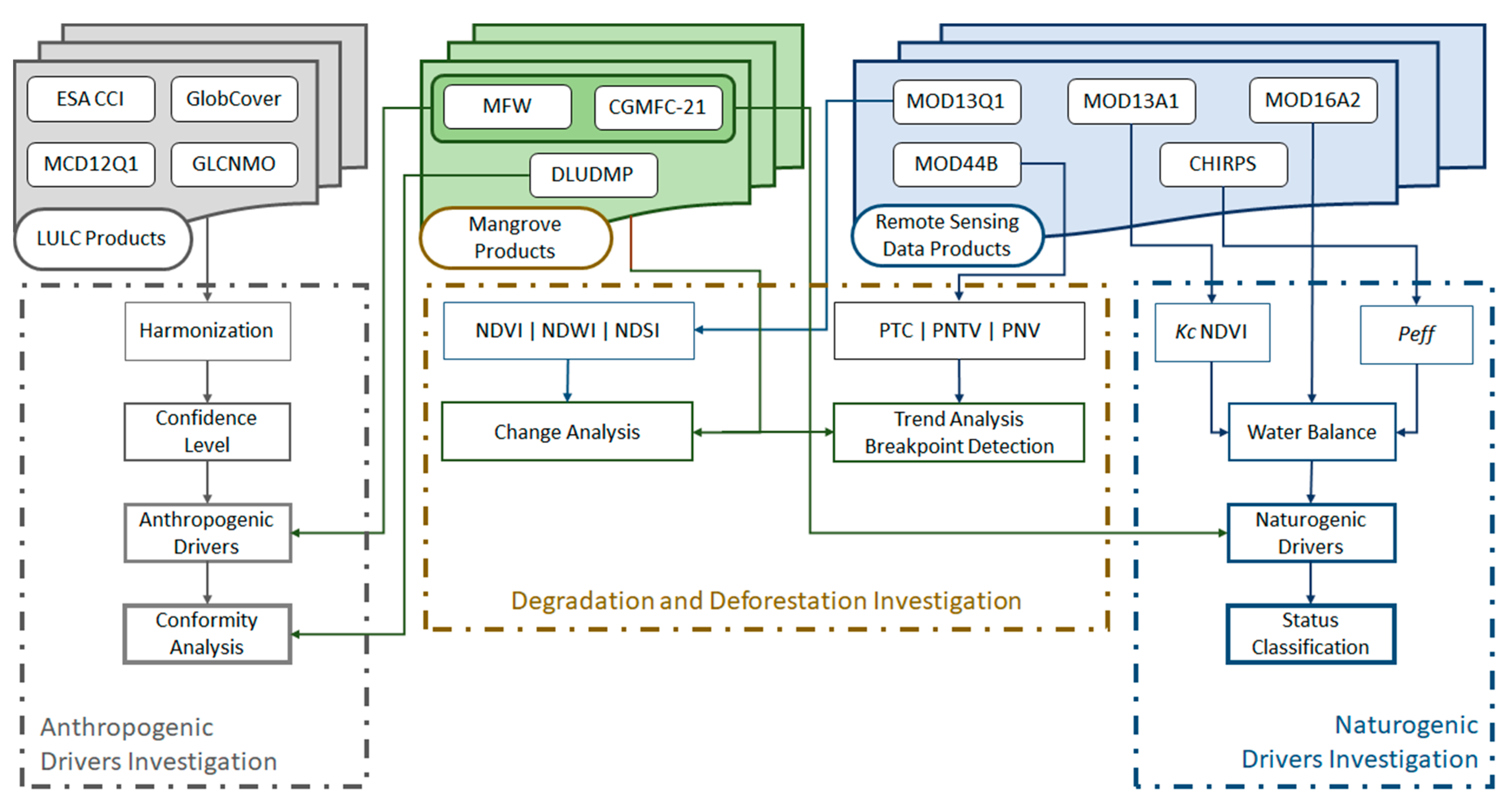
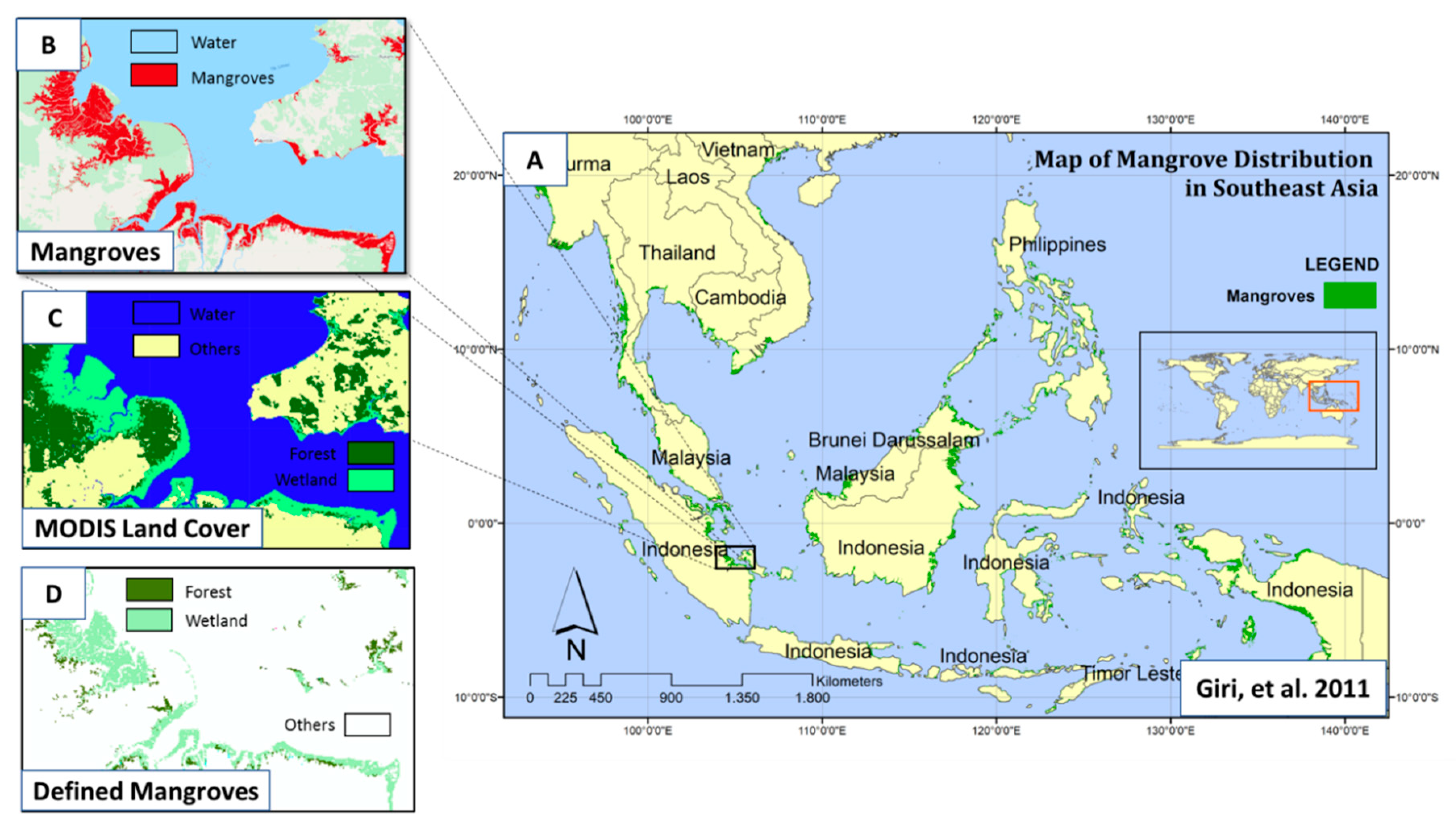

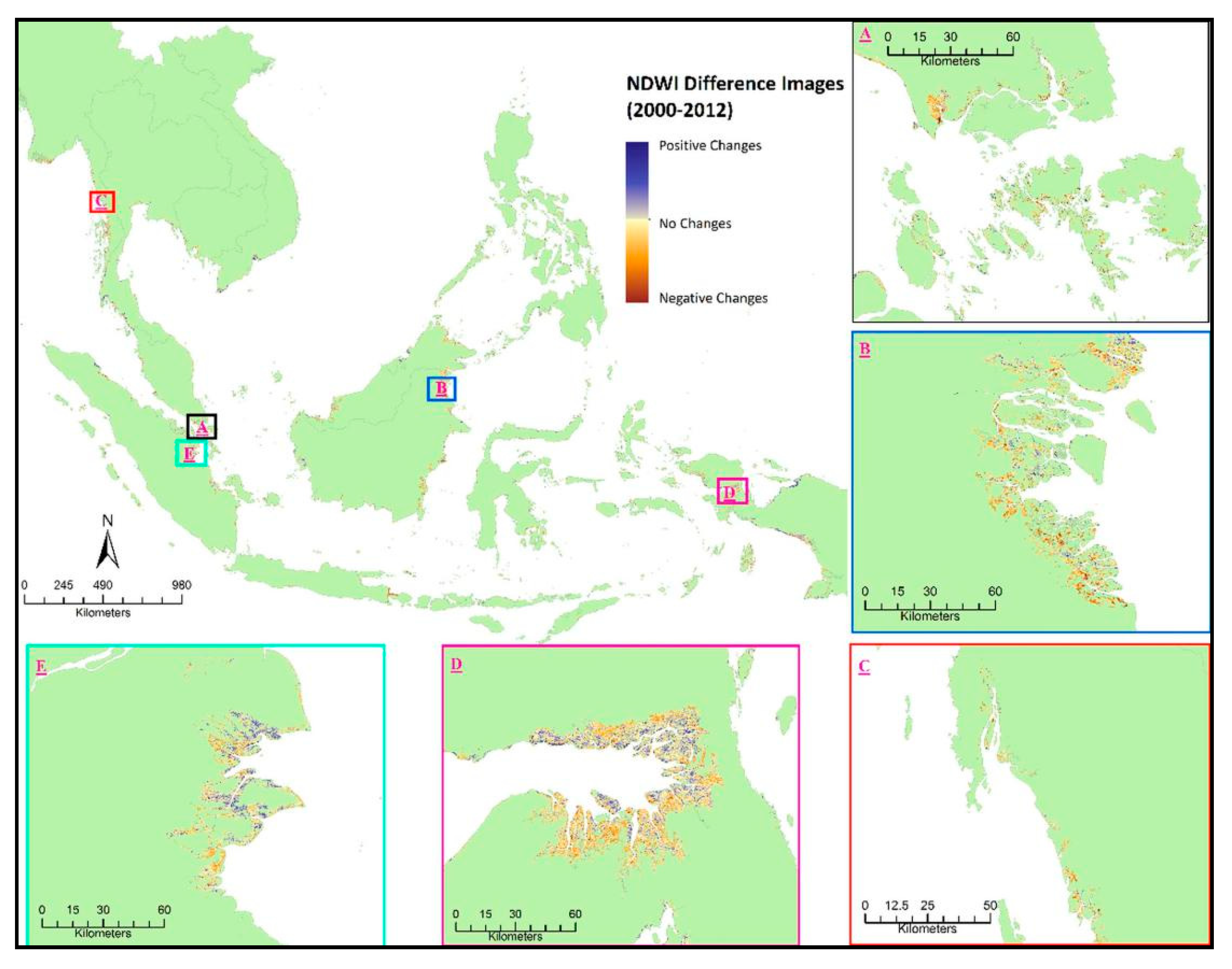


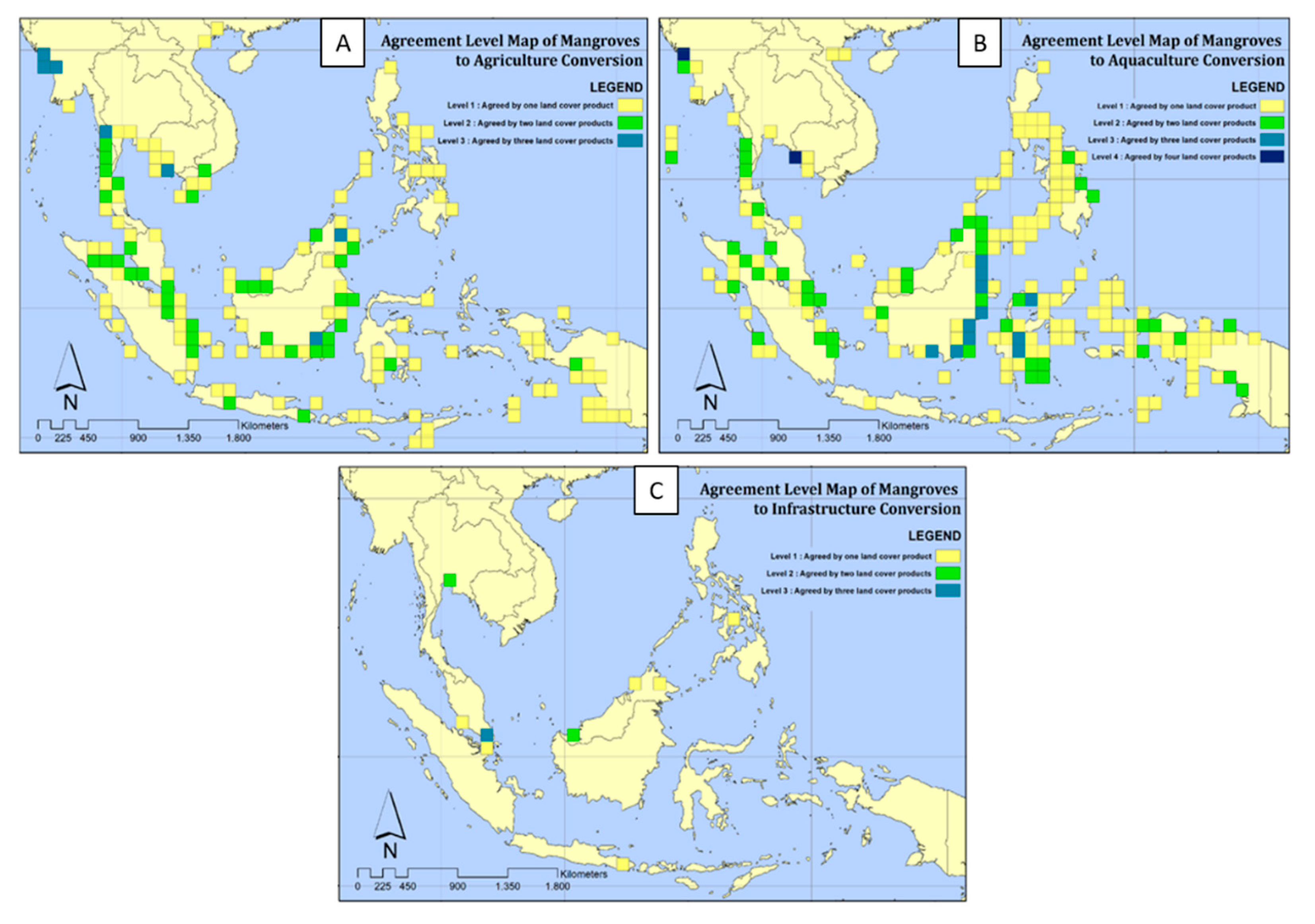

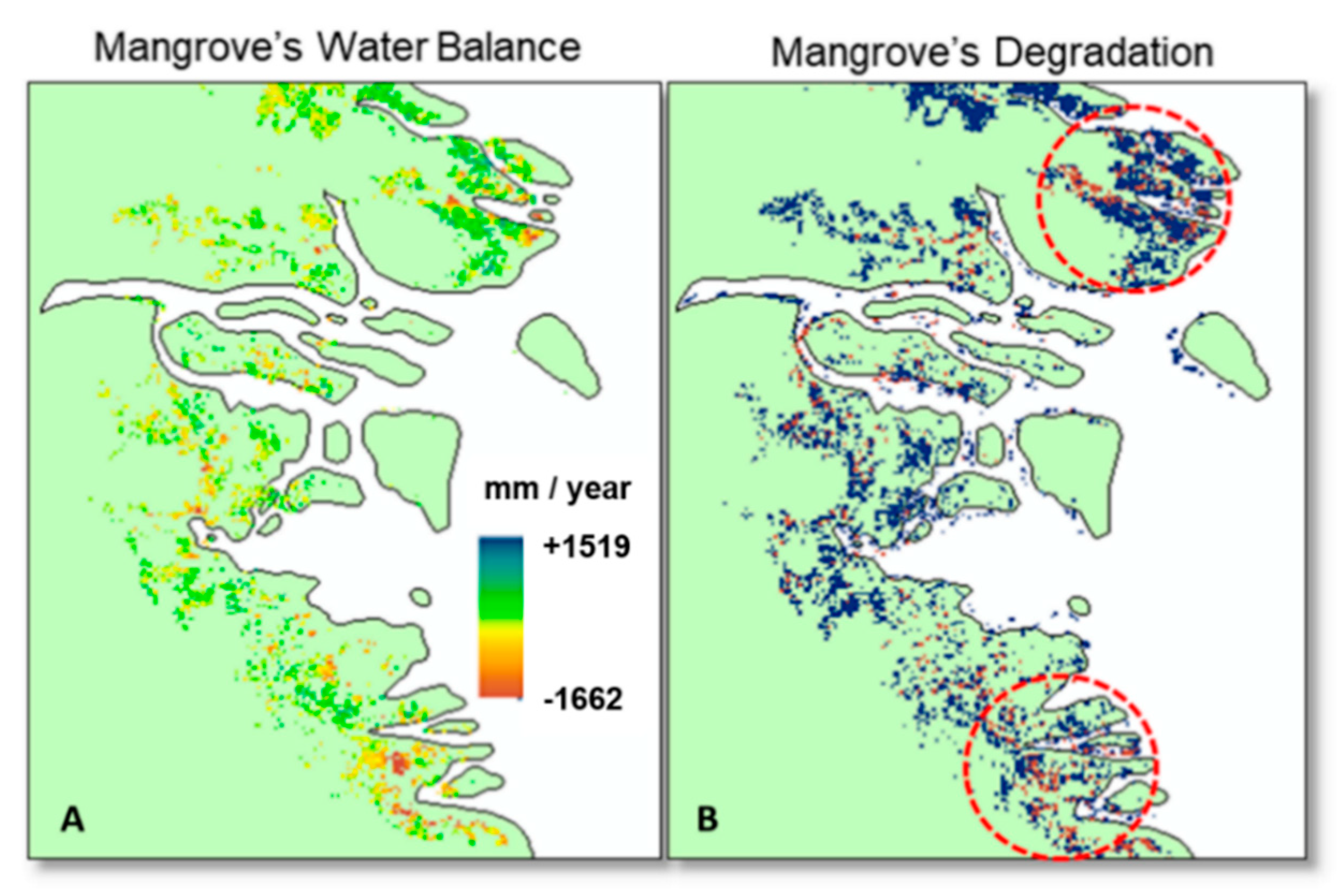



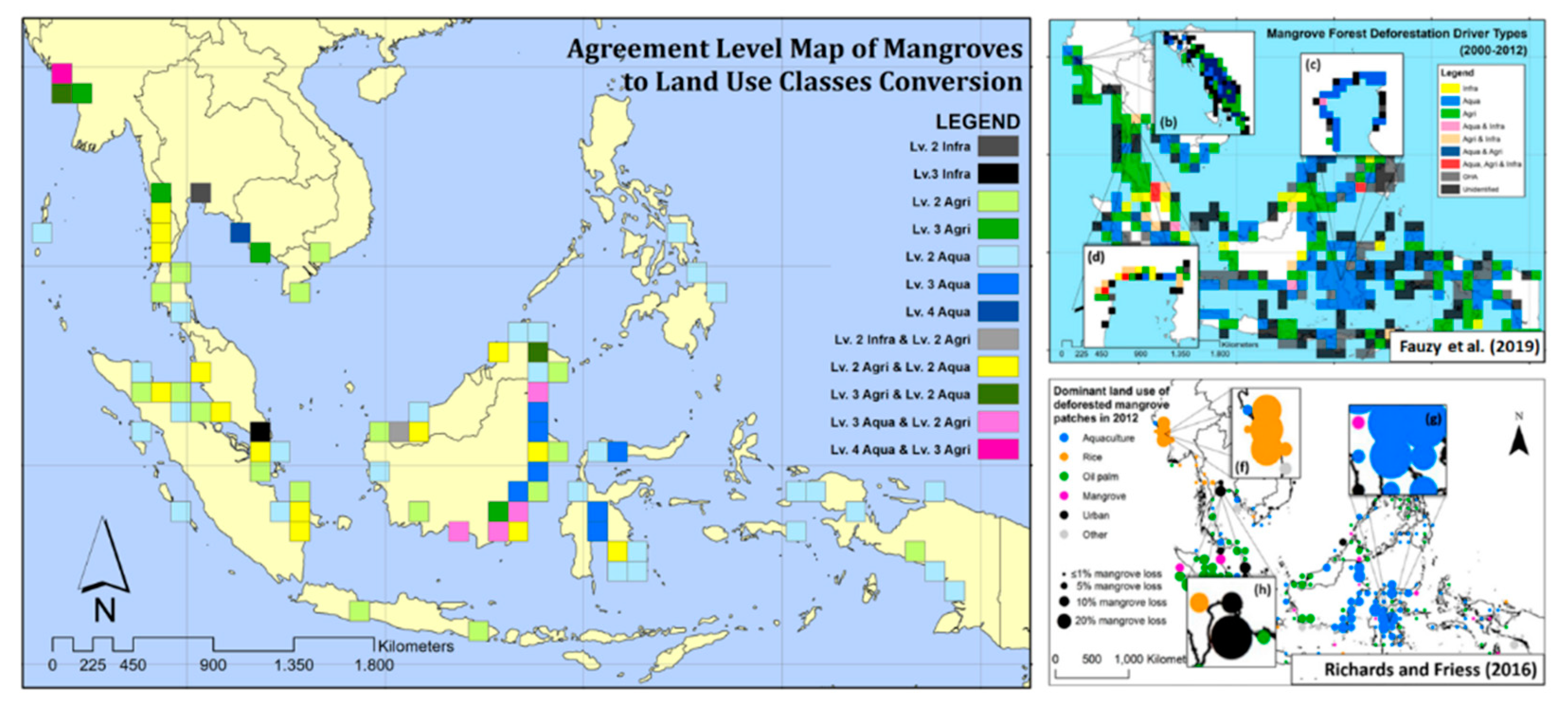
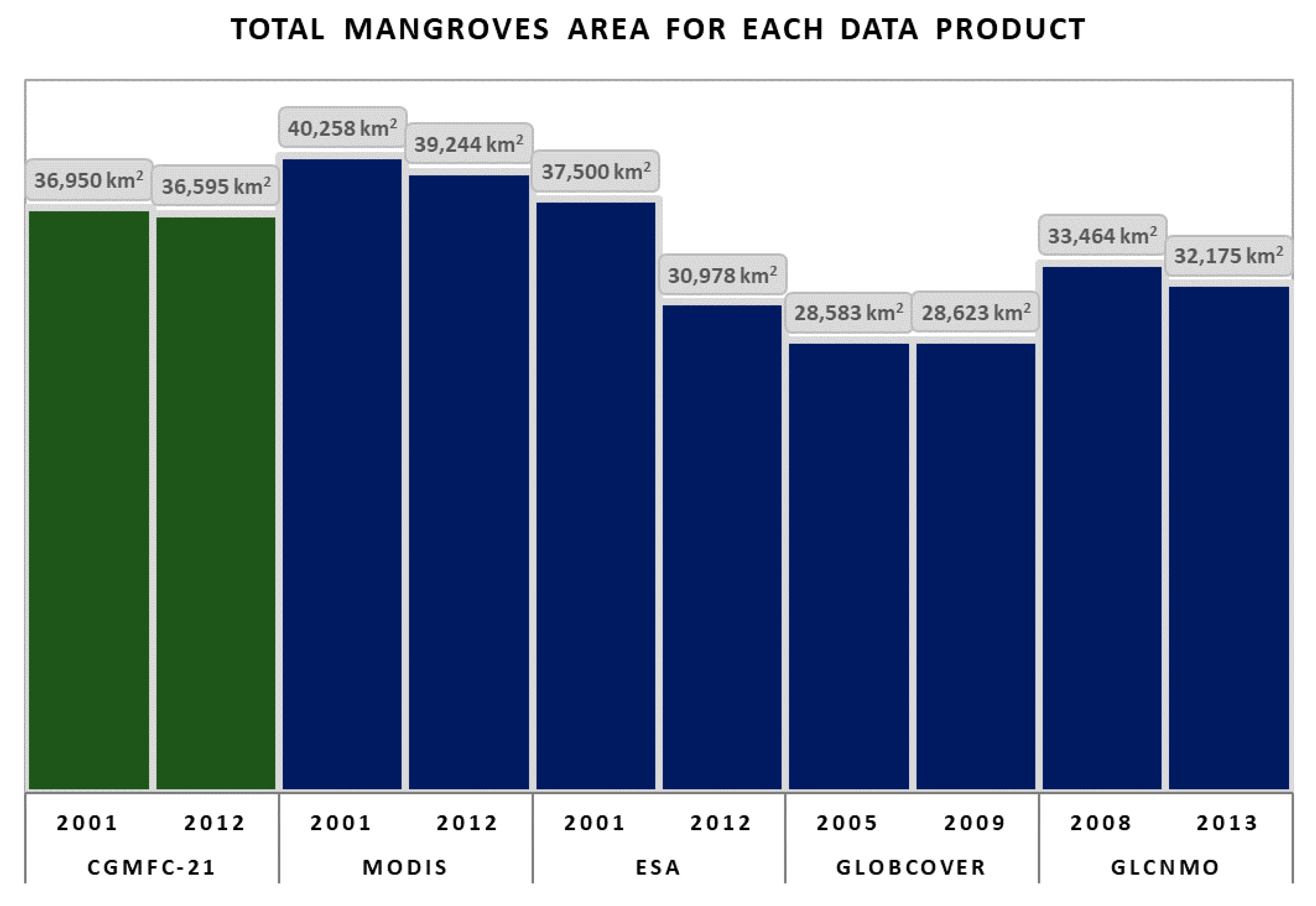

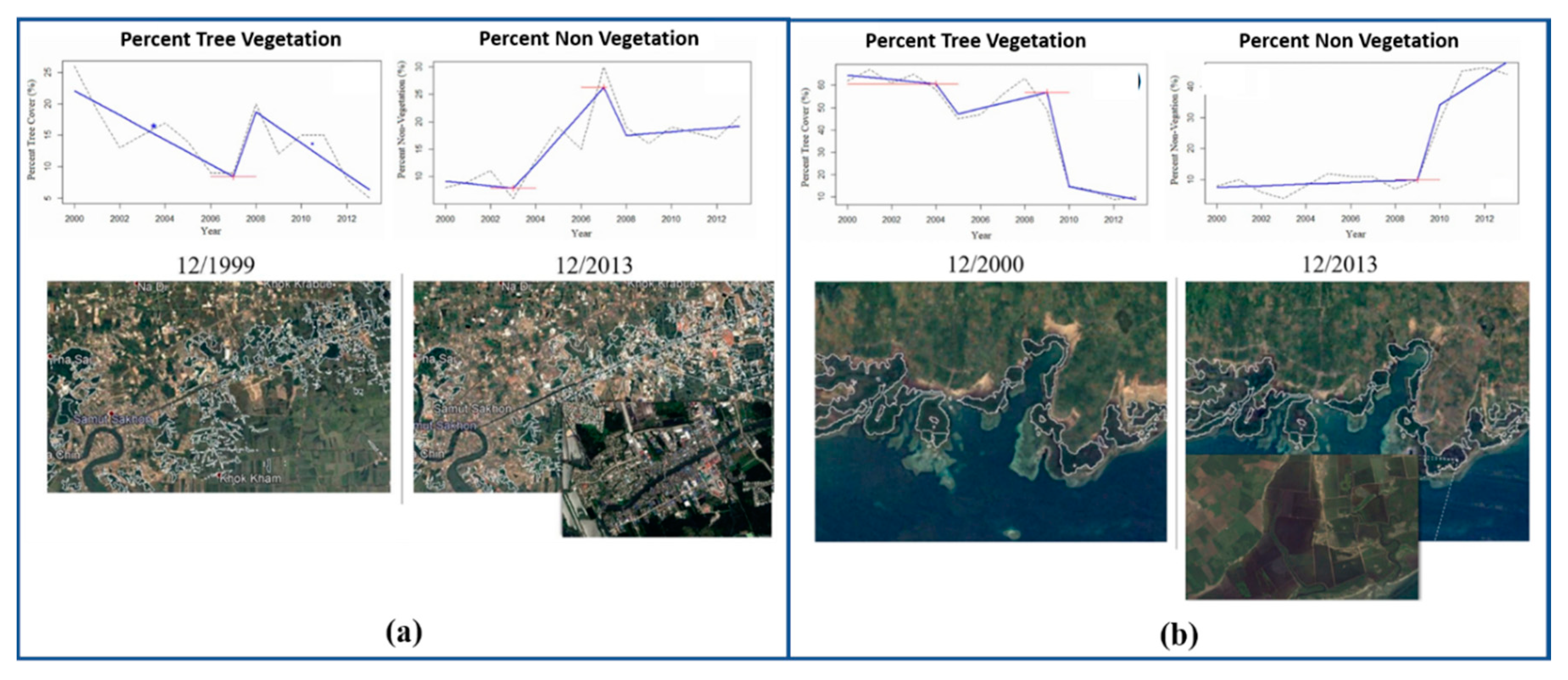
| Data Product | Data Class | Spatial Resolution | Available Year | Source |
|---|---|---|---|---|
| MFW-USGS | Mangrove Distribution | 30 m | 1997–2000 | [40] |
| CGMFC-21 | Mangrove deforestation | 30 m | 2001, 2005, 2009, and 2012 | [9] |
| DLUDMP | Function of dominant land | 1° | 2012 | [10] |
| SEAMCT | Mangroves Conversion Types | 10 km | 2000 and 2012 | [52] |
| Data Product | Data Class | Spatial Resolution | Data Acquisition | Source |
|---|---|---|---|---|
| ESA CCI Land Cover | Land cover | 300 m | 2001 and 2012 | [64] |
| MCD12Q1 | Land cover | 500 m | 2001 and 2012 | [65] |
| GlobCover | Land cover | 300 m | 2005 and 2009 | [66] |
| GLCNMO2008 | Land cover | 500 m | 2008 and 2012 | [68,69] |
| Data Product | Data Class | Spatial Resolution | Temporal Resolution | Source |
|---|---|---|---|---|
| MOD13Q1 v006 | VI and SR | 250 m | 2000 and 2012 | [70] |
| MOD13A1 v006 | Vegetation Indices | 500 m | 2002 and 2012 | [71] |
| MOD16A2 v005 | Evapotranspiration | 500 m | 2002 and 2012 | [75] |
| CHIRPS v02 | Precipitation | ~5.3 km | 2002 and 2012 | [79] |
| MOD44B v6 | PTC, PNTV, PNV | 250 m | 2000–2013 | [80] |
| Land Cover Product | Class | Description | Classification Reference |
|---|---|---|---|
| ESA CCI Land Cover | Forest | Trees with large and/or pointy greenish and yellowish leaves, open or closed alongside bush and grass, which have a canopy cover of 15% and over. | Land Cover Classification System (LCCS) |
| Wetland | Trees inundated with fresh water or sea water, mixed in with the bush or grass | ||
| GlobCover | Forest | Trees with large leaves and/or pointy greenish or yellowish leaves, open or closed with a height of 5 m, mixed in with other vegetation, such as bush and grass, with a minimum canopy cover of 15–40%. | Land Cover Classification System (LCCS) from FAO |
| Wetland | Vegetation (Grass, Bush, Wood Vegetation), open and closed, inundated by fresh or sea water (>15%). | ||
| MODIS Land Cover | Forest | Trees with large or pointy leaves, greenish or yellowish, with a height of more than 2 m and a canopy cover of more than 60%. | International Geosphere-Biosphere Programme (IGBP) Legend and Class |
| Wetland | Land where 30–60% of its area is permanently inundated with fresh water or seawater, covered by at least 10% from other vegetation. | ||
| GLCNMO | Mangrove | - | Land Cover Classification System (LCCS) from FAO |
| Land Cover Product | Early Land Cover Class | Ultimate Land Cover Class | Type of Conversion of Land Cover from Mangrove Deforestation |
|---|---|---|---|
| ESA CCI Land Cover, MODIS Land Cover, and GlobCover | Forest | Agriculture | Mangrove to farming |
| Wetlands | Mangrove to fishery | ||
| Water | Mangrove to fishery | ||
| Urban | Mangrove to housing | ||
| Wetlands | Agriculture | Mangrove to farming | |
| Water | Mangrove to fishery | ||
| Urban | Mangrove to housing | ||
| GLCNMO | Mangrove | Agriculture | Mangrove to farming |
| Wetlands | Mangrove to fishery | ||
| Water | Mangrove to fishery | ||
| Urban | Mangrove to housing |
| Criteria | Classification |
|---|---|
| Water Balance Surplus and Mangroves Degraded | Anthropogenic Drivers |
| Water Balance Deficit and Mangroves Degraded | Naturogenic Driver |
| Water Balance Deficit and Mangroves Not Degraded | Mangrove at Risk |
| Water Balance Surplus and Mangroves Not Degraded | Sustainable Mangrove |
| Mangrove Forest Conversion Area Based on Global Land Cover Data Products (GLCM) | Width Percentage (GLCM) | Width Percentage (DLUDMP) | Width Percentage (SEAMCT) | Difference between GLCM and DLUDMP | Difference between GLCM and SEAMCT | |
|---|---|---|---|---|---|---|
| MODIS (2001 dan 2012) | Farming | 8.19% | 52.70% | 77.59% | 44.52% | 69.40% |
| Fishery | 88.12% | 41.47% | 20.05% | 46.65% | 68.08% | |
| Housing | 3.69% | 5.83% | 2.36% | 2.14% | 1.33% | |
| GlobCover (2005 and 2009) | Farming | 92.42% | 52.70% | 77.59% | 39.71% | 14.83% |
| Fishery | 5.76% | 41.47% | 20.05% | 35.71% | 14.29% | |
| Housing | 1.83% | 5.83% | 2.36% | 4.00% | 0.54% | |
| ESA CCI LC (2001 and 2012) | Farming | 77.07% | 52.70% | 77.59% | 24.36% | 0.52% |
| Fishery | 21.85% | 41.47% | 20.05% | 19.62% | 1.81% | |
| Housing | 1.08% | 5.83% | 2.36% | 4.75% | 1.29% | |
| GLCNMO (2008 and 2012) | Farming | 55.63% | 52.70% | 77.59% | 2.92% | 21.96% |
| Fishery | 44.26% | 41.47% | 20.05% | 2.79% | 24.21% | |
| Housing | 0.12% | 5.83% | 2.36% | 5.71% | 2.25% | |
© 2020 by the authors. Licensee MDPI, Basel, Switzerland. This article is an open access article distributed under the terms and conditions of the Creative Commons Attribution (CC BY) license (http://creativecommons.org/licenses/by/4.0/).
Share and Cite
Sakti, A.D.; Fauzi, A.I.; Wilwatikta, F.N.; Rajagukguk, Y.S.; Sudhana, S.A.; Yayusman, L.F.; Syahid, L.N.; Sritarapipat, T.; Principe, J.A.; Trang, N.T.Q.; et al. Multi-Source Remote Sensing Data Product Analysis: Investigating Anthropogenic and Naturogenic Impacts on Mangroves in Southeast Asia. Remote Sens. 2020, 12, 2720. https://doi.org/10.3390/rs12172720
Sakti AD, Fauzi AI, Wilwatikta FN, Rajagukguk YS, Sudhana SA, Yayusman LF, Syahid LN, Sritarapipat T, Principe JA, Trang NTQ, et al. Multi-Source Remote Sensing Data Product Analysis: Investigating Anthropogenic and Naturogenic Impacts on Mangroves in Southeast Asia. Remote Sensing. 2020; 12(17):2720. https://doi.org/10.3390/rs12172720
Chicago/Turabian StyleSakti, Anjar Dimara, Adam Irwansyah Fauzi, Felia Niwan Wilwatikta, Yoki Sepwanto Rajagukguk, Sonny Adhitya Sudhana, Lissa Fajri Yayusman, Luri Nurlaila Syahid, Tanakorn Sritarapipat, Jeark A. Principe, Nguyen Thi Quynh Trang, and et al. 2020. "Multi-Source Remote Sensing Data Product Analysis: Investigating Anthropogenic and Naturogenic Impacts on Mangroves in Southeast Asia" Remote Sensing 12, no. 17: 2720. https://doi.org/10.3390/rs12172720
APA StyleSakti, A. D., Fauzi, A. I., Wilwatikta, F. N., Rajagukguk, Y. S., Sudhana, S. A., Yayusman, L. F., Syahid, L. N., Sritarapipat, T., Principe, J. A., Trang, N. T. Q., Sulistyawati, E., Utami, I., Arief, C. W., & Wikantika, K. (2020). Multi-Source Remote Sensing Data Product Analysis: Investigating Anthropogenic and Naturogenic Impacts on Mangroves in Southeast Asia. Remote Sensing, 12(17), 2720. https://doi.org/10.3390/rs12172720










